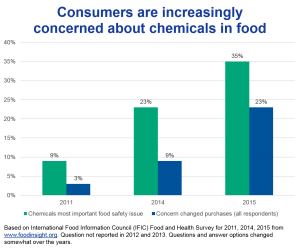[pullquote]Senator Markey (D-MA) asked FDA if it can require a label to tell consumers when the food they are eating contains chemicals it has not reviewed for safety. In his April 26 letter, he asked the agency to respond by May 17.
[/pullquote]Tom Neltner, J.D., is Chemicals Policy Director.
In May 2015, 36% of consumers said that chemicals in food was their most important food safety issue and 23% of consumer said they changed their purchase habits out of concern with chemicals in their food. Leading food manufacturers responded by reformulating their products to remove artificial flavors and colors.
What if these same consumers knew that chemicals added to their food had not been reviewed for safety by the Food and Drug Administration (FDA)? As the Natural Resources Defense Council made clear two years ago, 56 food additive makers chose to avoid FDA’s scrutiny by taking advantage of a loophole in the law for “Generally Recognized as Safe” (GRAS) substances. They purposely chose not to be transparent by keeping secret the safety evaluation conducted by their employees or consultants. These companies appear to make only a few of the estimated 1000 chemicals that FDA has not checked for safety or is aware they exist.
In February, we learned that 51% of consumers think that safety means not only that a product is free of harmful ingredients but that its labeling is clear and accurate. Forty-seven percent want clear information on ingredients and sourcing. With this in mind, it’s fair to assume that consumers also expect that all food chemicals are safe and known to the FDA. Many consumers would likely not buy products where the labeling failed to disclose that the food they serve their families contained ingredients the FDA has admitted it “cannot vouch for their safety”.
On April 26, Senator Edward Markey (D-MA) put the issue front and center when he asked FDA whether it has “sufficient authority to require a special label on any foods or beverages containing ingredients that have been self-determined to be GRAS without an FDA review?” If FDA had sufficient authority, then “what would the label look like?” Read More
